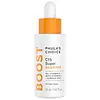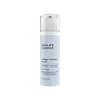What's inside
What's inside
 Key Ingredients
Key Ingredients

 Benefits
Benefits

 Concerns
Concerns

No concerns
 Ingredients Side-by-side
Ingredients Side-by-side

Water
Skin ConditioningAscorbic Acid
AntioxidantGlycerin
HumectantEthoxydiglycol
HumectantPPG-26-Buteth-26
Skin ConditioningMannitol
HumectantTridecapeptide-1
Skin ConditioningPalmitoyl Tripeptide-5
Skin ConditioningErgothioneine
AntioxidantSodium Hyaluronate
HumectantPentylene Glycol
Skin ConditioningPEG-40 Hydrogenated Castor Oil
EmulsifyingBisabolol
MaskingSodium Gluconate
Skin ConditioningDecylene Glycol
Skin ConditioningFerulic Acid
AntimicrobialOryza Sativa Bran Extract
Skin ConditioningTocopherol
AntioxidantPolyacrylate Crosspolymer-6
Emulsion Stabilising1,2-Hexanediol
Skin ConditioningPanthenol
Skin ConditioningSodium Phytate
Sodium Hydroxide
BufferingCitric Acid
BufferingPhenoxyethanol
PreservativeWater, Ascorbic Acid, Glycerin, Ethoxydiglycol, PPG-26-Buteth-26, Mannitol, Tridecapeptide-1, Palmitoyl Tripeptide-5, Ergothioneine, Sodium Hyaluronate, Pentylene Glycol, PEG-40 Hydrogenated Castor Oil, Bisabolol, Sodium Gluconate, Decylene Glycol, Ferulic Acid, Oryza Sativa Bran Extract, Tocopherol, Polyacrylate Crosspolymer-6, 1,2-Hexanediol, Panthenol, Sodium Phytate, Sodium Hydroxide, Citric Acid, Phenoxyethanol
Water
Skin ConditioningGlycerin
HumectantDiheptyl Succinate
EmollientCandelilla/Jojoba/Rice Bran Polyglyceryl-3 Esters
EmulsifyingLinum Usitatissimum Seed Oil
PerfumingLinoleic Acid
CleansingLinolenic Acid
CleansingPassiflora Edulis Seed Oil
EmollientCeramide EOP
Skin ConditioningCeramide Eos
Skin ConditioningCeramide NP
Skin ConditioningCeramide Ns
Skin ConditioningCaprooyl Sphingosine
Skin ConditioningOlea Europaea Oil Unsaponifiables
Skin ConditioningCaprooyl Phytosphingosine
Skin ConditioningSodium Hyaluronate
HumectantCholesterol
EmollientCeramide AP
Skin ConditioningButyrospermum Parkii Butter Unsaponifiables
Skin ConditioningTocopherol
AntioxidantHydroxyethyl Acrylate/Sodium Acryloyldimethyl Taurate Copolymer
Emulsion StabilisingPrunus Domestica Seed Oil
Skin ConditioningLauryl Laurate
Skin ConditioningGlyceryl Behenate
EmollientHydrogenated Lecithin
EmulsifyingSodium Phytate
Trehalose
HumectantIsohexadecane
EmollientSodium Stearoyl Lactylate
EmulsifyingCapryloyl Glycerin/Sebacic Acid Copolymer
Skin ConditioningXanthan Gum
EmulsifyingCetyl Alcohol
EmollientTetrahexyldecyl Ascorbate
AntioxidantAgar
MaskingGlyceryl Stearate
EmollientCeteareth-25
CleansingCetearyl Alcohol
EmollientBehenic Acid
CleansingGlyceryl Rosinate
PerfumingCitric Acid
BufferingBenzyl Alcohol
PerfumingEthylhexylglycerin
Skin ConditioningWater, Glycerin, Diheptyl Succinate, Candelilla/Jojoba/Rice Bran Polyglyceryl-3 Esters, Linum Usitatissimum Seed Oil, Linoleic Acid, Linolenic Acid, Passiflora Edulis Seed Oil, Ceramide EOP, Ceramide Eos, Ceramide NP, Ceramide Ns, Caprooyl Sphingosine, Olea Europaea Oil Unsaponifiables, Caprooyl Phytosphingosine, Sodium Hyaluronate, Cholesterol, Ceramide AP, Butyrospermum Parkii Butter Unsaponifiables, Tocopherol, Hydroxyethyl Acrylate/Sodium Acryloyldimethyl Taurate Copolymer, Prunus Domestica Seed Oil, Lauryl Laurate, Glyceryl Behenate, Hydrogenated Lecithin, Sodium Phytate, Trehalose, Isohexadecane, Sodium Stearoyl Lactylate, Capryloyl Glycerin/Sebacic Acid Copolymer, Xanthan Gum, Cetyl Alcohol, Tetrahexyldecyl Ascorbate, Agar, Glyceryl Stearate, Ceteareth-25, Cetearyl Alcohol, Behenic Acid, Glyceryl Rosinate, Citric Acid, Benzyl Alcohol, Ethylhexylglycerin
 Reviews
Reviews

Ingredients Explained
These ingredients are found in both products.
Ingredients higher up in an ingredient list are typically present in a larger amount.
Citric Acid is an alpha hydroxy acid (AHA) naturally found in citrus fruits like oranges, lemons, and limes.
Like other AHAs, citric acid can exfoliate skin by breaking down the bonds that hold dead skin cells together. This helps reveal smoother and brighter skin underneath.
However, this exfoliating effect only happens at high concentrations (20%) which can be hard to find in cosmetic products.
Due to this, citric acid is usually included in small amounts as a pH adjuster. This helps keep products slightly more acidic and compatible with skin's natural pH.
In skincare formulas, citric acid can:
While it can provide some skin benefits, research shows lactic acid and glycolic acid are generally more effective and less irritating exfoliants.
Most citric acid used in skincare today is made by fermenting sugars (usually from molasses). This synthetic version is identical to the natural citrus form but easier to stabilize and use in formulations.
Read more about some other popular AHA's here:
Learn more about Citric AcidGlycerin is already naturally found in your skin. It helps moisturize and protect your skin.
A study from 2016 found glycerin to be more effective as a humectant than AHAs and hyaluronic acid.
As a humectant, it helps the skin stay hydrated by pulling moisture to your skin. The low molecular weight of glycerin allows it to pull moisture into the deeper layers of your skin.
Hydrated skin improves your skin barrier; Your skin barrier helps protect against irritants and bacteria.
Glycerin has also been found to have antimicrobial and antiviral properties. Due to these properties, glycerin is often used in wound and burn treatments.
In cosmetics, glycerin is usually derived from plants such as soybean or palm. However, it can also be sourced from animals, such as tallow or animal fat.
This ingredient is organic, colorless, odorless, and non-toxic.
Glycerin is the name for this ingredient in American English. British English uses Glycerol/Glycerine.
Learn more about GlycerinSodium Hyaluronate is hyaluronic acid's salt form. It is commonly derived from the sodium salt of hyaluronic acid.
Like hyaluronic acid, it is great at holding water and acts as a humectant. This makes it a great skin hydrating ingredient.
Sodium Hyaluronate is naturally occurring in our bodies and is mostly found in eye fluid and joints.
These are some other common types of Hyaluronic Acid:
Learn more about Sodium HyaluronateSodium Phytate is the synthetic salt form of phytic acid. Phytic acid is an antioxidant and can be found in plant seeds.
Sodium Phytate is a chelating agent. Chelating agents help prevent metals from binding to water. This helps stabilize the ingredients and the product.
Tocopherol (also known as Vitamin E) is a common antioxidant used to help protect the skin from free-radicals and strengthen the skin barrier. It's also fat soluble - this means our skin is great at absorbing it.
Vitamin E also helps keep your natural skin lipids healthy. Your lipid skin barrier naturally consists of lipids, ceramides, and fatty acids. Vitamin E offers extra protection for your skin’s lipid barrier, keeping your skin healthy and nourished.
Another benefit is a bit of UV protection. Vitamin E helps reduce the damage caused by UVB rays. (It should not replace your sunscreen). Combining it with Vitamin C can decrease sunburned cells and hyperpigmentation after UV exposure.
You might have noticed Vitamin E + C often paired together. This is because it is great at stabilizing Vitamin C. Using the two together helps increase the effectiveness of both ingredients.
There are often claims that Vitamin E can reduce/prevent scarring, but these claims haven't been confirmed by scientific research.
Learn more about TocopherolWater. It's the most common cosmetic ingredient of all. You'll usually see it at the top of ingredient lists, meaning that it makes up the largest part of the product.
So why is it so popular? Water most often acts as a solvent - this means that it helps dissolve other ingredients into the formulation.
You'll also recognize water as that liquid we all need to stay alive. If you see this, drink a glass of water. Stay hydrated!
Learn more about Water